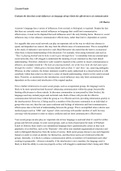Essay
A Level English Language Social Groups Sociolect A* Essay:
- Institution
- AQA
This A-Level English Language AQA Essay covers the Social Groups/Sociolects topic of the course, and achieved an A*. The essay title is: 'Evaluate the idea that social influences on language always limit the effectiveness of communication'. This is perfect for Year 12 and 13 students currently stud...
[Show more]



